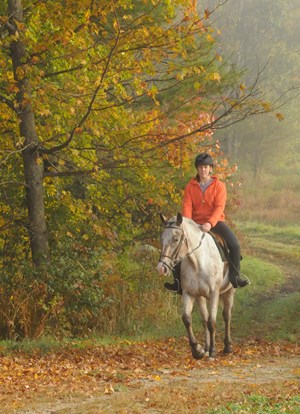Many equestrian sports have an annual cycle in which a competition season is followed by an off-season. Even in disciplines that continue year-round, most trainers schedule a break to give a horse a chance to recover mentally and physically from the stress of traveling and competing. But providing an equine athlete with some downtime rarely means abandoning work altogether. Significant swings in fitness are detrimental to long-term soundness, so it is best not to let down a horse completely unless he is recuperating from injury.

Systematically deconditioning an equine athlete—reducing his work schedule yet ensuring that he retains a certain baseline level of fitness—makes it easier to recondition him for the next competitive season. It is particularly important for older horses because reconditioning takes longer with age. The key to formulating an effective plan for a period of “active rest” or “roughing off” is to consider the whole horse as well as the specific body systems that are affected.
Fitness Factors
A horse’s conditioning process for competition generally focuses on three distinct but complementary areas:
1. Cardiovascular fitness—the ability of his respiratory, cardiovascular and muscular systems to produce energy.
2. Musculoskeletal strength—the power or endurance of the muscle groups that are essential to the performance of his sport.
3. Suppleness—the range of motion of joints, which can make a horse more athletic, improve the aesthetics of his performance and reduce the risk of injury.
Just as regular work maintains fitness, a reduction or cessation of activity causes it to decline. And the rate at which fitness diminishes determines the time required for reconditioning. Studies show that horses rested for six months due to injury have difficulty completing a standard exercise test: They sweat more than when they were fit, their breathing is labored and there is a marked increase in the concentration of lactic acid in the blood after exercise due to reduced aerobic capacity.
In contrast, a strategic layoff of a month or less has relatively little effect on an equine athlete’s performance. There is some minimal loss of cardiovascular fitness, but it is restored relatively quickly. Even so, when training resumes, a horse’s workload should be reintroduced gradually over a period of several days.
As a rule of thumb, each month beyond the first one that a horse has off requires a month’s reconditioning. But some areas of fitness take longer to restore. For instance, musculoskeletal strength is regained relatively slowly. Muscle strength can usually be preserved with a single weekly workout, but other components of the musculoskeletal system—tendons and ligaments—lose strength more rapidly than it can be rebuilt; they do not adapt as quickly as muscle to increases in work.
A Sound Strategy
Consult with your trainer and veterinarian not only to develop a suitable off-season plan for your horse but also to map out how you will eventually return him to work. Take approximately two weeks to transition your equine athlete from his competition schedule to layoff. Gradually decrease his diet as his workload declines. Increase his daily turnout and then two to three times a week, ride him for pleasure at a reduced intensity and duration from your typical training program. Most people ride two to three times a week for 30 to 60 minutes a day in the off-season. This type of cardiovascular workout will preserve the strength and suppleness of the horse’s musculoskeletal tissues and only slightly reduce his cardiovascular fitness. As a result, he will be prepared when the time comes to recondition him.
In addition, if it’s cool enough for blankets, remove them, one at a time, as your horse begins to grow a longer, thicker coat. Also consider pulling his shoes for a couple of months, if possible, to encourage a healthier foot to grow.
Dr. Hilary Clayton, president of Sport Horse Science LC, is a speaker, author and consultant in the area of equine sports science. This article has been adapted with permission from the American Association of Equine Practitioners.
This article originally appeared in the January 2015 issue of Practical Horseman.










